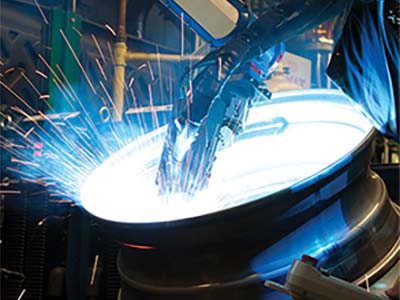Robots on a Dime
Small Shop Automation
Robotic welding typically conjures up images of long-armed, six-axis robots on an industrial assembly line, constantly twisting and turning to perform welds on high-capacity products such as automobile bodies and panels. For many metfab shop owners, robots also create sobering visions like the high cost of ownership and concerns about versatility to meet production needs. But like many technologies, robotic welding is fast becoming more affordable and flexible for smaller shops that are looking for ways to streamline operations and boost production. “We are trying to make applying a robot as easy as applying a drill press to production for shop owners,” said industry veteran Brian Doyle, Sales Manager, Miller Welding Automation. “We’re not quite there yet, but we’re getting closer.” Praxair is teaming with Miller, which distributes Panasonic robotic welding products in North America to offer ProStar® pre-engineered welding systems. The series features Tawers WG3 and WGH3 integrated power source and robotic arm combinations for GMAW and GTAW applications. Each unit is built on a single frame, pre-wired and pre-assembled for quick installation and relocation in shops. The pre-engineered systems provide shop owners with immediate benefits, said Doyle, who has worked in the robotics industry since the early 1980s. These systems are favored in small and medium-sized shops. 
“These robots are manufactured to make them affordable for everyone,” he added. “The pre-wiring and pre-assembly drive down the delivery time compared to custom work cells, and we can provide customer service even faster because the systems are standardized. If there’s an issue, we can work with customers to identify it quickly and get them back up and running.” The economical ProStar PRS-55 model has a compact footprint (66-x-113 inches) that makes it easy to reposition with a forklift to accommodate workflow or shop changes. The PRS-55 also features a manually driven, two-station turntable with 60-inch table diameter, ideal for batch volumes of small parts welded in one position or walked through a progressive fixture. Larger models include servo positioning for accurate, fast indexing and can be upgraded with options such as a torch cleaner, seam tracking, task lighting and more. The PRS-112S and PRS-122S models can be fitted with dual robots for high production applications. As for the question of economics, it’s simple, Doyle said. ProStar robotic systems will triple productivity compared to manual welding, as well as deliver consistent weld quality and greatly enhanced arc-on time.
“What robots allow you to do is have 60 to 90 percent arc-on time, compared to 15 to 20 percent for a typical welder,” he explained. “Where the economic justification really comes in is the three to-one productivity gain that a shop owner will experience. Say a welder can work at the bench and finish 100 parts a day. That same operator can be feeding the robotic cell and finish 300 parts a day.” With the integrated operator control panel, users can run the system from a central location using the panel’s full-color teach pendant that enables full system control, diagnostics and programming capability. “It’s much easier to teach workers how to use these robots compared to older models. I think it might be because of video games,” Doyle added with a laugh. “Young workers today seem to take to it much faster than workers of 10 to 20 years ago did.” Young operators cranking out consistently built, precision-welded parts – that’s an image shop owners can take to the bank.




























